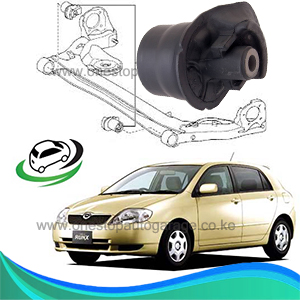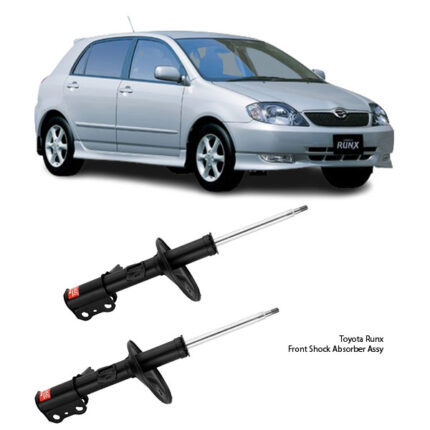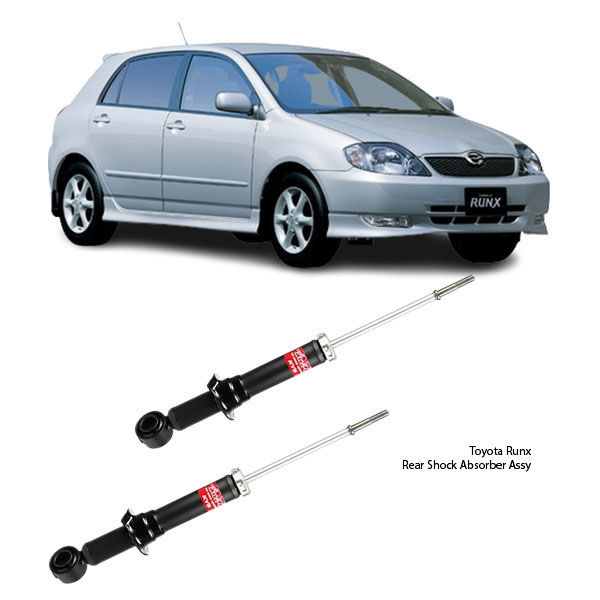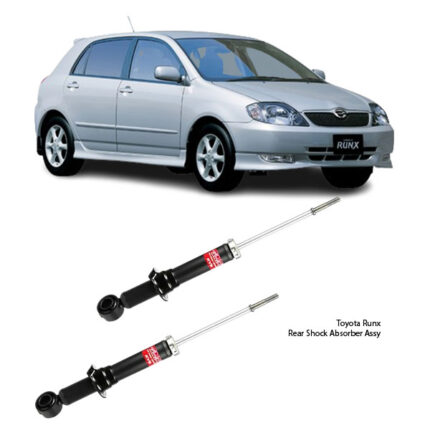Get Toyota Corolla Runx/Allex 2wd Rear Shock Absorber Assy 341307 in Kenya
When you drive over a bump or pothole and your vehicle remains stable and smooth, you’ve got the rear shock absorber assembly to thank. Often overlooked, yet essential, this component is a true workhorse — it absorbs jolts, manages weight transfer, and keeps your tyres planted firmly on the road.
Whether you’re hauling cargo, cruising on uneven terrain, or navigating sharp corners, your rear shock absorbers play a critical role in ensuring comfort, control, and safety from the rear axle.
Let’s explore what a rear shock absorber assembly is, how it works, its benefits, and why it’s vital to replace it on time.
What Is a Rear Shock Absorber Assembly?
A rear shock absorber assembly is a complete unit that includes the shock absorber itself and often its mounting components — such as bushings, bolts, and brackets — designed to connect the suspension to the vehicle’s chassis.
It serves one primary purpose: to dampen and control suspension movement. This is especially important at the rear of the vehicle where stability, traction, and load balance are managed during acceleration, braking, and cornering.
How It Works
Every time your vehicle goes over a bump, the wheels move up and down. Without shock absorbers, this movement would be uncontrolled, leading to constant bouncing and loss of grip.
The rear shock absorber works using hydraulic damping. Inside the shock is a piston that moves through oil. This movement slows down the motion of the suspension through resistance — creating a damping effect that stabilizes the vehicle.
Key parts include:
Piston and Rod – Moves up and down to create pressure
Hydraulic Oil – Absorbs energy from movement
Valves – Control the flow of oil and damping force
Mounting Bushings – Absorb noise and vibrations
Dust Covers – Protect internal parts from debris
Rear vs. Front – What’s the Difference?
While both shock absorbers serve similar functions, the rear shocks typically handle:
Load carrying and weight distribution
Rear-end stability during acceleration
Control of body sway and roll
Traction under varying loads
If you frequently carry passengers or cargo in the rear, the condition of your rear shocks becomes even more important. Weak or failing rear shocks can compromise the handling of the entire vehicle.
Benefits of a Healthy Rear Shock Absorber Assembly
-
Ride Comfort – Smooths out bumps and reduces harshness
-
Handling & Control – Keeps the rear end from bouncing or sliding
-
Tyre Longevity – Ensures consistent tyre contact, reducing uneven wear
-
Safety – Helps maintain traction during emergency maneuvers
-
Protection for Other Components – Reduces strain on the suspension, chassis, and tyres
A well-functioning rear shock absorber means better fuel efficiency, fewer repairs, and more enjoyable driving.
Signs of Worn Rear Shocks
Shock absorbers wear gradually, and many drivers don’t notice the change until handling or comfort worsens. Here’s what to watch for:
Excessive bouncing after bumps
Uneven rear tyre wear
Poor stability while turning
Nose-diving or rear-end squatting
Clunking noises or fluid leaks
A bouncy or drifting feel on highways
If you notice any of these symptoms, it’s time to inspect or replace your rear shock absorber assembly. Don’t wait until it affects your entire suspension system.
When Should Rear Shocks Be Replaced?
There’s no one-size-fits-all answer, but most shocks need replacing every 60,000–100,000 km, depending on:
Driving conditions (rough roads wear them faster)
Load habits (frequent cargo/passenger weight increases wear)
Type of shock absorber (gas vs. hydraulic)
Vehicle design and usage
A good rule of thumb: inspect your shocks every 20,000 km or during routine maintenance.
What’s in a Rear Shock Absorber Assy?
A complete rear shock absorber assembly usually includes:
Shock Absorber Unit – The core hydraulic or gas damper
Upper and Lower Mounts – With pre-installed bushings
Dust Boot – Shields internal components from dirt and rocks
Internal Valve System – Precision tuned to your vehicle specs
Spring Seat or Bracket – For models with rear coilover assemblies
Some advanced models include gas-charged technology or are adjustable, offering improved performance or customizable damping for different driving conditions.
Genuine vs Aftermarket – What Should You Choose?
| Feature | Genuine (OEM) | High-Quality Aftermarket |
|---|---|---|
| Fitment | Perfect vehicle match | Good if brand is reputable |
| Performance | Matches original ride quality | Can be better for heavy use or comfort |
| Price | Typically higher | More budget-friendly |
| Durability | Reliable and tested | Varies – stick to trusted names |
At Onestop Garage & Auto Spares, we stock both OEM and premium aftermarket rear shock assemblies, ensuring every client finds the perfect balance of performance and value.
Replacing the Rear Shock Absorber – The Process
While it’s best done by a professional, here’s a basic idea of what replacement involves:
-
Lift the vehicle safely and remove the rear wheels
-
Unbolt the old shock at both top and bottom mounts
-
Check bushings and brackets for damage
-
Install the new shock absorber with proper torque
-
Reinstall wheels and test drive
Tip: Always replace rear shocks in pairs to maintain balanced suspension response.
Why Timely Replacement Matters
Neglecting rear shocks can lead to:
Loss of rear-end control
Increased braking distance
Rear tyre damage or blowouts
Wear on suspension arms, springs, and bushings
Driver and passenger discomfort
Replacing them on time is not just maintenance — it’s smart ownership.
Follow us on Facebook for more parts.




